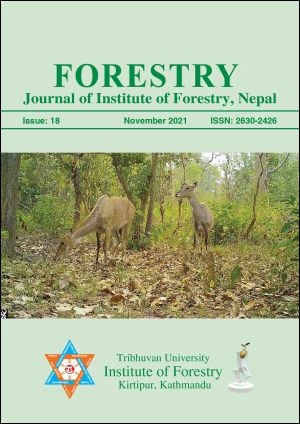Spatio-Temporal Patterns of Common Leopard Attacks: A Case Study from Aadhikhola Rural Municipality, Syangja
DOI:
https://doi.org/10.3126/forestry.v18i01.41759Keywords:
Common Leopard attacks Kernel, density, predator-proof corrals, risk zonation, safety analysisAbstract
Information on the spatio-temporal patterns of attacks in certain areas contributes to the designing and implementation of effective mitigation measures. The aim of this study was to assess spatial distribution of Common Leopard attacks to highlight conflict risk zone and temporal trend in Aadhikhola Rural Municipality of Syangja districts from 2016 AD to 2019 AD. Data was collected as registered cases caused by Common Leopard at the Division Forest Office, Syangja according to the Wildlife Damage Relief Guideline, 2013 AD. Total cases were 187 with the highest incidents (n=66) in ward no. 4 (Bangsing). The highest cases occurred in summer (44%) followed by spring (20%). By month the highest number of attacks occurred in July (22%) followed by June, May. Most of the attacks occurred inside livestock sheds (84%), during day time (69%), with goats being the major prey. Kernel Density Estimation (KDE) was used for safety analysis. Kernel density attack layer was reclassified using the geometric interval algorithm to generate five risk zones of leopard attacks. Wangsing, Deurali, Faparthum, Setidovan were very high risk zone for leopard attacks. Predator-proof corrals/ enclosures and improved herding and guarding practices are suggested to reduce livestock losses.
Downloads
Downloads
Published
How to Cite
Issue
Section
License
© Tribhuvan University, Institute of Forestry




